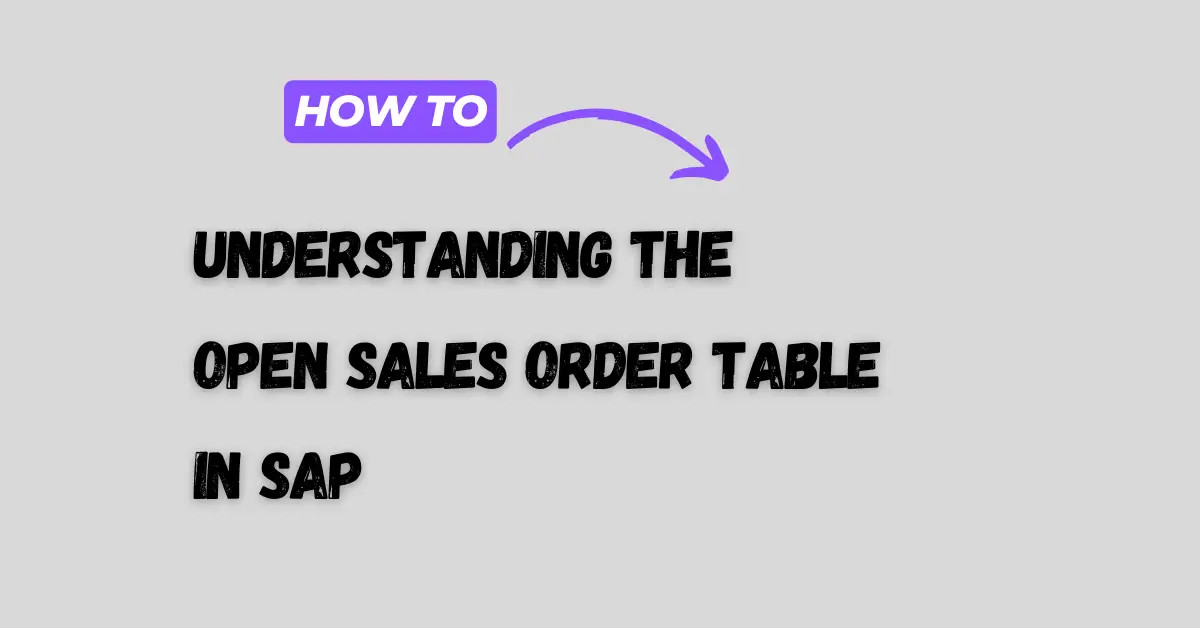Understanding the Open Sales Order Table in SAP
In the SAP system, managing and tracking open sales orders table in sap is crucial for effective sales and inventory management. Open sales orders refer to orders that have been created but not yet fulfilled or completed. This blog post will introduce the concept of open sales orders, the key tables involved, and how to write SQL queries to extract open sales order data.

Key Open Sales Order Tables in SAP
To manage open sales orders in SAP, the following tables are commonly used:
- VBAK (Sales Document: Header Data)
- Contains header-level information for sales documents, including sales order type, date, customer, and status.
- VBAP (Sales Document: Item Data)
- Stores item-level details such as material number, quantity, and pricing for each sales order.
- VBEP (Sales Document: Schedule Line Data)
- Holds schedule line information, specifying delivery dates and quantities.
- VBUK (Sales Document: Header Status and Administrative Data)
- Contains status information at the header level, indicating the overall status of the sales order (e.g., open, completed, or blocked).
- VBUP (Sales Document: Item Status)
- Stores status information at the item level, showing the status of each item in the sales order.
Identifying Open Sales Orders
An open sales order is typically identified by checking the status fields in the VBUK and VBUP tables. Key status fields include:
- VBUK-GBSTK (Overall Processing Status)
- Indicates the overall status of the sales document. Common values include ‘A’ (open), ‘B’ (partially processed), and ‘C’ (completed).
- VBUP-GBSTA (Item Processing Status)
- Indicates the status of individual items within the sales order.
Example SQL Queries
- Retrieve Basic Open Sales Order Information
To get a list of open sales orders with basic header and item details, you can join VBAK, VBAP, VBUK, and VBUP:
SELECT
VBAK.VBELN AS Sales_Order,
VBAK.KUNNR AS Customer,
VBAK.AUART AS Order_Type,
VBAP.POSNR AS Item_Number,
VBAP.MATNR AS Material,
VBAP.MENGE AS Quantity,
VBAP.NETPR AS Net_Price
FROM
VBAK
JOIN
VBAP ON VBAK.VBELN = VBAP.VBELN
JOIN
VBUK ON VBAK.VBELN = VBUK.VBELN
JOIN
VBUP ON VBAP.VBELN = VBUP.VBELN AND VBAP.POSNR = VBUP.POSNR
WHERE
VBUK.GBSTK = 'A'; -- Overall Status: Open
- Retrieve Open Sales Orders with Delivery Schedule
To get open sales orders along with their delivery schedules, join VBAK, VBAP, VBEP, VBUK, and VBUP:
SELECT
VBAK.VBELN AS Sales_Order,
VBAP.POSNR AS Item_Number,
VBEP.ETENR AS Schedule_Line,
VBEP.EDATU AS Delivery_Date,
VBEP.MENGE AS Schedule_Quantity
FROM
VBAK
JOIN
VBAP ON VBAK.VBELN = VBAP.VBELN
JOIN
VBEP ON VBAP.VBELN = VBEP.VBELN AND VBAP.POSNR = VBEP.POSNR
JOIN
VBUK ON VBAK.VBELN = VBUK.VBELN
JOIN
VBUP ON VBAP.VBELN = VBUP.VBELN AND VBAP.POSNR = VBUP.POSNR
WHERE
VBUK.GBSTK = 'A' -- Overall Status: Open
AND VBUP.GBSTA = 'A'; -- Item Status: Open
- Retrieve Open Sales Orders with Partner Information
To include partner information for open sales orders, join VBAK, VBAP, VBUK, VBUP, and VBPA:
SELECT
VBAK.VBELN AS Sales_Order,
VBPA.PARVW AS Partner_Function,
VBPA.KUNNR AS Partner_Number,
VBAK.KUNNR AS Customer,
VBAK.AUART AS Order_Type,
VBAP.POSNR AS Item_Number,
VBAP.MATNR AS Material,
VBAP.MENGE AS Quantity,
VBAP.NETPR AS Net_Price
FROM
VBAK
JOIN
VBAP ON VBAK.VBELN = VBAP.VBELN
JOIN
VBUK ON VBAK.VBELN = VBUK.VBELN
JOIN
VBUP ON VBAP.VBELN = VBUP.VBELN AND VBAP.POSNR = VBUP.POSNR
JOIN
VBPA ON VBAK.VBELN = VBPA.VBELN
WHERE
VBUK.GBSTK = 'A' -- Overall Status: Open
AND VBUP.GBSTA = 'A'; -- Item Status: Open
Conclusion
Managing open sales orders in SAP requires understanding the key tables and their relationships. By leveraging tables like VBAK, VBAP, VBEP, VBUK, and VBUP, you can effectively track and analyze open sales orders. Writing SQL queries to join these tables allows you to extract valuable information, helping you make informed decisions and optimize sales processes.
You might be interested to learn about MM Tables in SAP


2 Comments
Comments are closed.